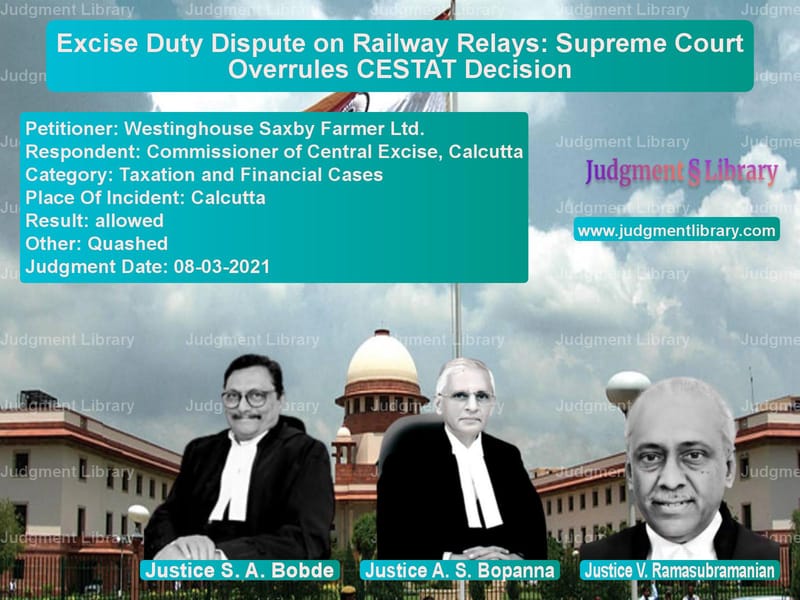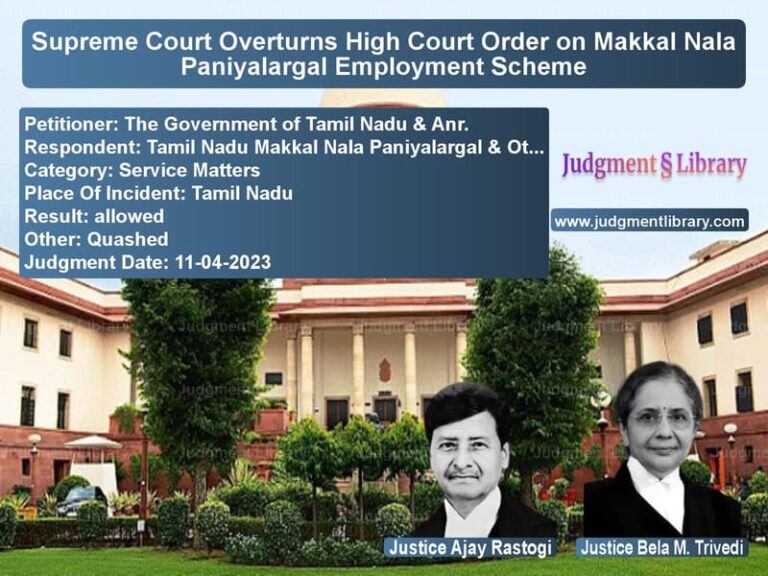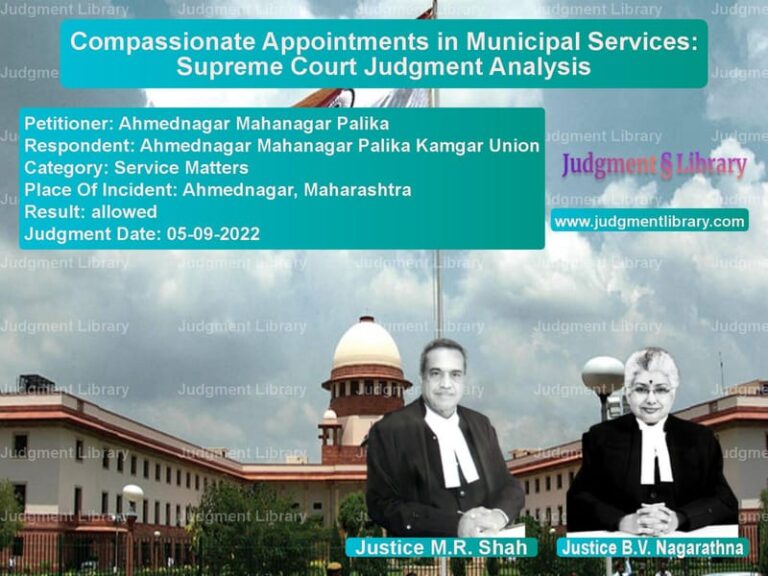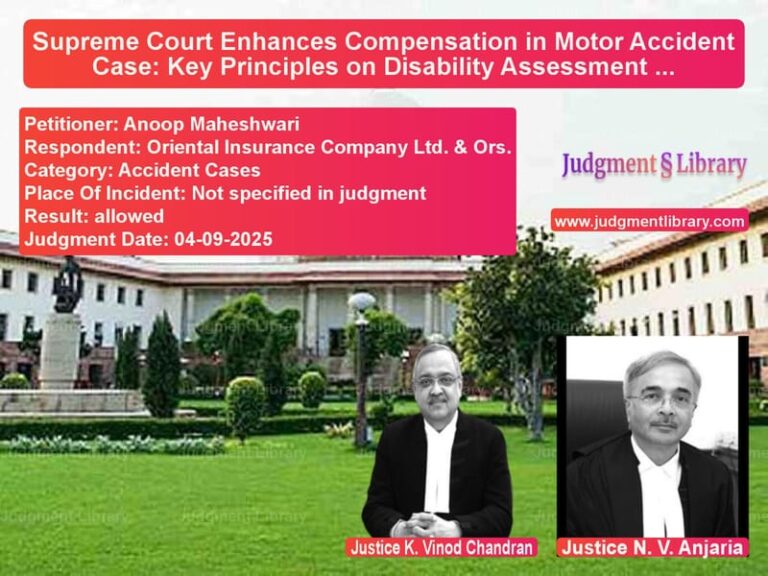Excise Duty Dispute on Railway Relays: Supreme Court Overrules CESTAT Decision
The Supreme Court of India delivered a crucial judgment in the case of Westinghouse Saxby Farmer Ltd. vs. Commissioner of Central Excise, Calcutta, addressing the classification of relays used in railway signaling equipment for excise duty purposes. The ruling overturned the decision of the Customs, Excise, and Service Tax Appellate Tribunal (CESTAT) and provided clarity on the applicability of excise duty rates to railway signaling components.
Background of the Case
Westinghouse Saxby Farmer Ltd., a state-owned company in West Bengal, manufactures electrical relays used exclusively in railway signaling systems. The dispute arose over the classification of these relays under the Central Excise Tariff Act, 1985.
Initially, until February 1993, the excise duty rate for both electrical relays (classified under Tariff Item 8536.90) and railway signaling equipment (classified under 8608) was 15%. However, after February 28, 1993, the excise duty rate for general electrical relays increased significantly, whereas railway signaling equipment attracted a lower rate.
To benefit from the reduced duty rate, the appellant submitted a revised classification list on August 27, 1993, proposing that its relays be classified under Chapter 86 (Railway Signaling Equipment) instead of Chapter 85 (Electrical Machinery). This classification was approved by the competent excise authority.
However, in 1996, the Central Board of Excise and Customs (CBEC) issued a circular stating that plug-in type relays should be classified under Chapter Heading 8536. Following this, the Assistant Commissioner of Central Excise issued multiple show-cause notices demanding differential excise duty from the appellant, contending that relays should be classified under Chapter 85 and not as railway signaling equipment under Chapter 86.
Arguments by the Petitioner (Westinghouse Saxby Farmer Ltd.)
- The relays manufactured by the company are used solely as railway signaling equipment and should therefore be classified under Tariff Item 8608.
- The classification list submitted in 1993 was duly approved by the excise authorities, and the company had been paying duty accordingly.
- The CBEC’s circular in 1996 should not have retrospective effect on previously approved classifications.
- The demand notices were time-barred under Section 11A of the Central Excise Act, as there was no fraudulent misrepresentation or suppression of facts.
- Electrical relays specifically designed for railway signaling must be considered part of railway equipment and should not be treated as general electrical machinery.
Arguments by the Respondent (Commissioner of Central Excise, Calcutta)
- As per the CBEC circular, plug-in relays fall under Chapter Heading 8536, covering electrical switches and similar equipment.
- Note 2(f) of Section XVII of the Excise Tariff explicitly states that “electrical machinery or equipment” classified under Chapter 85 cannot be considered as “parts” under Chapter 86.
- The relays manufactured by the appellant are not uniquely identifiable as railway equipment and, therefore, should be classified under Chapter 85.
- The show-cause notices were valid as the appellant misrepresented the classification of relays.
Supreme Court’s Observations
The Supreme Court analyzed the classification dispute and made the following key observations:
- Legal Basis for Classification: The Court examined the General Rules for Interpretation of the Excise Tariff and found that the description of goods should be determined by their primary use.
- Specific vs. General Classification: The Court held that relays used exclusively in railway signaling systems should be classified under Chapter 86, overriding the CBEC’s classification under Chapter 85.
- Reliance on Note 2(f): The Court ruled that Note 2(f) does not apply when the equipment is designed solely for use in railway applications.
- Time-Barred Demands: The Court found that the excise department failed to establish fraud, suppression, or willful misrepresentation by the appellant. Hence, the extended period for duty recovery under Section 11A could not be invoked.
- Precedents and Interpretative Principles: The Court cited previous judgments emphasizing that classification should align with the intended use of the product. The “sole or principal use test” should take precedence over broad categorizations.
Supreme Court’s Judgment
The Supreme Court ruled in favor of Westinghouse Saxby Farmer Ltd., overturning the decisions of the Adjudicating Authority, the Commissioner (Appeals), and CESTAT. The key orders issued by the Court were:
- The classification of railway signaling relays under Chapter 86 was upheld.
- The show-cause notices demanding differential duty were quashed.
- The penalties imposed on the appellant were set aside.
- The Court reaffirmed that approved classifications cannot be arbitrarily altered without new evidence or justification.
Impact of the Judgment
The ruling has significant implications for excise duty classifications, particularly for railway-related equipment:
- Clarification on Railway Equipment: Manufacturers of railway signaling components can now rely on this ruling to classify their products under Chapter 86.
- Limits on Retrospective Classification Changes: Excise authorities cannot arbitrarily revise classifications approved by competent authorities.
- Protection Against Unjustified Tax Demands: Businesses cannot be held liable for duty differentials based on later-issued CBEC circulars.
- Emphasis on “Use-Based” Classification: The Court reinforced the principle that classification should be based on the intended purpose of goods.
Conclusion
The Supreme Court’s judgment in this case marks a crucial victory for manufacturers of railway signaling equipment. It upholds the principle that excise duty classifications should be determined based on product usage rather than arbitrary interpretations by tax authorities. The ruling ensures consistency in taxation and protects businesses from retrospective and unjustified tax demands.
Petitioner Name: Westinghouse Saxby Farmer Ltd..Respondent Name: Commissioner of Central Excise, Calcutta.Judgment By: Justice S. A. Bobde, Justice A. S. Bopanna, Justice V. Ramasubramanian.Place Of Incident: Calcutta.Judgment Date: 08-03-2021.
Don’t miss out on the full details! Download the complete judgment in PDF format below and gain valuable insights instantly!
Download Judgment: westinghouse-saxby-f-vs-commissioner-of-cent-supreme-court-of-india-judgment-dated-08-03-2021.pdf
Directly Download Judgment: Directly download this Judgment
See all petitions in Income Tax Disputes
See all petitions in GST Law
See all petitions in Tax Evasion Cases
See all petitions in Tax Refund Disputes
See all petitions in Banking Regulations
See all petitions in Judgment by S. A. Bobde
See all petitions in Judgment by A. S. Bopanna
See all petitions in Judgment by V. Ramasubramanian
See all petitions in allowed
See all petitions in Quashed
See all petitions in supreme court of India judgments March 2021
See all petitions in 2021 judgments
See all posts in Taxation and Financial Cases Category
See all allowed petitions in Taxation and Financial Cases Category
See all Dismissed petitions in Taxation and Financial Cases Category
See all partially allowed petitions in Taxation and Financial Cases Category







